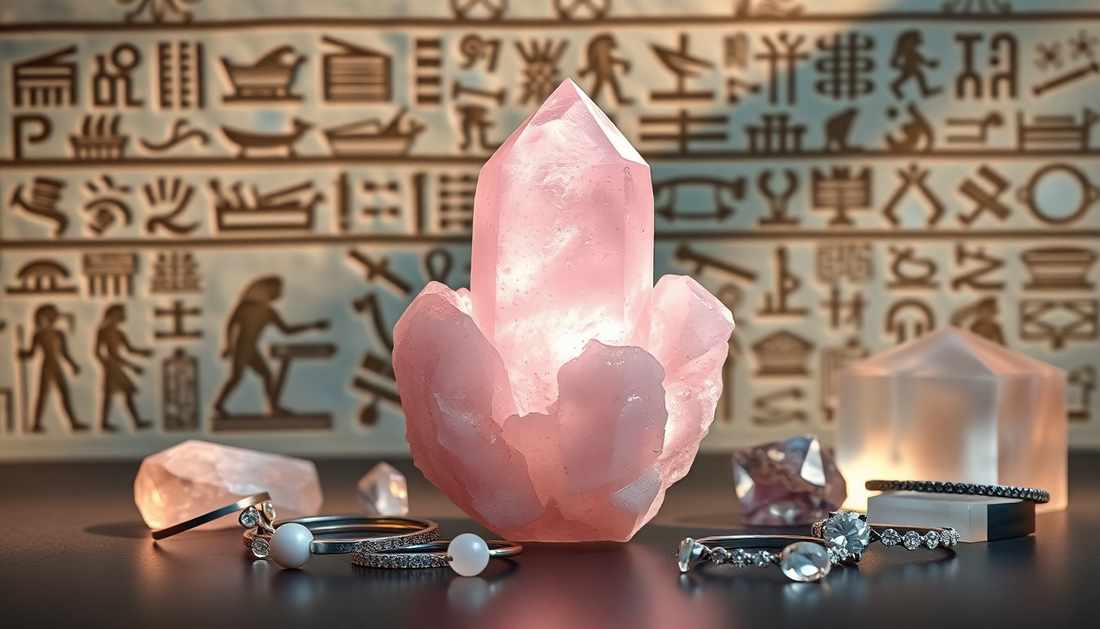
The Fascinating History of Rose Quartz: From Ancient Civilizations to Modern Times
Share
Rose quartz, a beloved gemstone known for its soft, pink hue, has a rich and captivating history that spans across centuries and continents. This delicate yet powerful crystal has long been revered for its unique properties and the profound symbolism it has held in various cultures throughout the ages. In this comprehensive blog post, we will delve into the fascinating history of rose quartz, exploring its significance in ancient civilizations and its enduring appeal in the modern world.
The Origins of Rose Quartz
Rose quartz is a variety of the mineral quartz, which is one of the most abundant and widely distributed minerals on Earth. The distinctive pink color of rose quartz is attributed to the presence of trace amounts of titanium, iron, or manganese within the crystal structure. This natural coloration has captivated the human imagination for millennia, leading to the gemstone's widespread use in jewelry, decorative objects, and spiritual practices.
Rose Quartz in Ancient Greece and Rome
The earliest known references to rose quartz can be traced back to ancient Greece and Rome, where the gemstone was highly prized and incorporated into various aspects of daily life. In ancient Greece, rose quartz was believed to have powerful healing properties and was often used in rituals and ceremonies. The Greeks associated the stone with the goddess Aphrodite, the embodiment of love and beauty, and it was commonly used in love charms and amulets.
Similarly, in ancient Rome, rose quartz was revered for its purported ability to promote harmony and balance in relationships. Roman aristocrats and nobility often adorned themselves with rose quartz jewelry, and the gemstone was also used in the creation of decorative objects and sculptures.
Rose Quartz in Ancient Egypt
The ancient Egyptians, known for their rich cultural heritage and advanced understanding of the natural world, also held rose quartz in high regard. The gemstone was believed to have protective and rejuvenating properties, and it was often used in the mummification process and in the creation of sacred objects and amulets. Archaeologists have uncovered numerous examples of rose quartz artifacts from ancient Egyptian tombs and temples, further underscoring the stone's significance in this ancient civilization.
The Symbolism of Rose Quartz
Throughout history, rose quartz has been imbued with a wide range of symbolic meanings, reflecting the diverse cultural and spiritual beliefs of the societies that revered it. In many traditions, the soft pink hue of rose quartz has been associated with love, compassion, and emotional healing, making it a popular choice for use in jewelry, meditation, and other spiritual practices.
Rose Quartz in Medieval Times
During the Middle Ages, rose quartz continued to be highly valued, particularly in Europe. The gemstone was often used in the creation of religious artifacts, such as rosary beads and reliquaries, and was believed to have the power to protect the wearer from harm and promote inner peace. Rose quartz was also incorporated into various forms of medieval art, including illuminated manuscripts and stained glass windows.
Rose Quartz in the Modern Era
In the modern era, rose quartz has maintained its enduring appeal, with its timeless beauty and symbolic significance continuing to captivate people around the world. The gemstone has become a popular choice for use in a wide range of jewelry and decorative items, as well as in the field of crystal healing and alternative medicine. Rose quartz is often associated with the heart chakra, the energy center believed to be responsible for our ability to love and be loved, and is used in meditation and other spiritual practices to promote emotional well-being and self-love.
Conclusion
The history of rose quartz is a testament to the enduring power of this captivating gemstone. From its ancient roots in the civilizations of Greece, Rome, and Egypt, to its continued significance in the modern world, rose quartz has consistently been revered for its unique beauty and the profound symbolism it represents. As we continue to explore the rich history and cultural significance of this remarkable crystal, we can appreciate the timeless allure of rose quartz and the ways in which it has touched the lives of people across the ages.